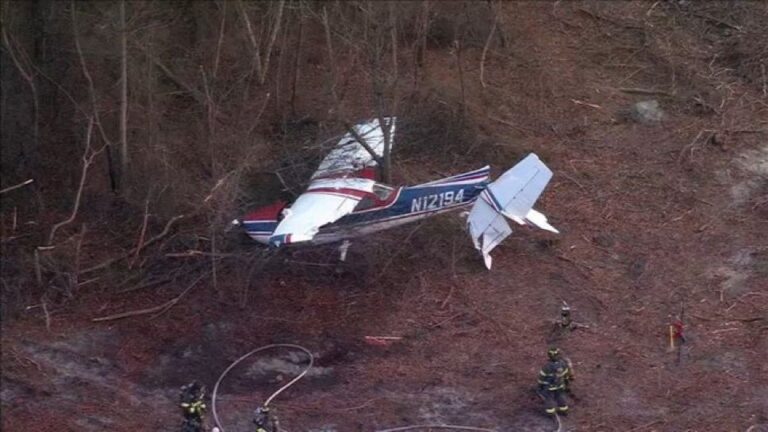 The commander of an Air France jet that crashed two years ago was in the cockpit, though not at the controls, as the crew struggled to recover from a high-altitude stall that occurred as the plane entered a zone of moderate turbulence over the mid-Atlantic, according to the initial chronology of the flight’s final moments published Friday by French air accident investigators.
The commander of an Air France jet that crashed two years ago was in the cockpit, though not at the controls, as the crew struggled to recover from a high-altitude stall that occurred as the plane entered a zone of moderate turbulence over the mid-Atlantic, according to the initial chronology of the flight’s final moments published Friday by French air accident investigators.
The report confirmed investigators’ initial hypothesis that a loss of consistent speed readings — likely due to icing of airspeed sensors on the plane’s wings and fuselage — triggered the chain of events that ultimately led to the crash of flight 447 on its way from Rio de Janeiro to Paris. But they said it was far too early to say whether the crash was the result of errors made by the pilots or a technical malfunction as the plane plummeted from 38,000 feet, slamming into the ocean three and a half minutes later at a speed of nearly 11,000 feet per minute.
“We are still trying to interpret this information in order to have a better understanding of what happened,” said Jean-Paul Troadec, the director of France’s Bureau of Investigations and Analyses, or BEA. “That work has just begun.”
“Our role is not to assess blame, merely to determine the facts,” he added.
The timeline published Friday was based on an initial synthesis of roughly 1,300 pieces of data from the plane’s computers and recordings of the final two hours of cockpit conversations. The information contained on the plane’s so-called black boxes, which were retrieved earlier this month from a sandy plain 3,900 meters below the surface and less than 10 kilometers from the point where air traffic controllers lost contact with the plane. The information was seen by investigators as a major breakthrough in the investigation, which has been stalled for nearly two years.
According to the report, the pilots’ first indication of a problem came three hours and 40 minutes into the flight, when the autopilot and auto-thrust functions of the plane — an Airbus A330-200 — disengaged; that was followed by the sounding, twice, of a stall warning.
“We’ve lost the speeds ,” said the co-pilot, as he took over manual control with the aircraft at a normal cruising altitude of 37,500 feet.
Just 10 minutes before, the plane’s captain, Marc Dubois, had gone to the crew rest area for some sleep — a normal procedure for such a long-distance flight, Air France has said. Before retiring, he and the two co-pilots discussed the weather conditions and noted that they were entering an area of rough air. Flight attendants were also warned to expect a rough ride.
Within seconds of losing the autopilot function, the co-pilot called the captain back to the cockpit. The plane’s flight displays continued to show inconsistent speed readings.
A faulty air speed indicator can mislead pilots into flying faster or slower than the plane can handle. In this case, investigators said, the plane abruptly lost speed, disrupting the flow of air over the wing.
The co-pilot who was at the controls responded to the warnings by pulling up the nose of the aircraft. As the plane slowed down, it began to ascend, reaching a peak altitude of 38,000 feet. A third stall warning sounded, lasting for about a minute.
Two minutes later, with the plane losing momentum and starting to roll to the left and right, the captain returned to the cockpit. The plane had fallen by about 3,000 feet and its nose was pointing upward at an angle of about 16 degrees.
The crew continued its struggle to restart the engines as the plane hurtled through 10,000 feet, its nose still pointed slightly upward.
Two minutes before impact with the water, the co-pilot, who was still at the controls, said he still had no airspeed information.
“We have no valid indications,” he said.
In the final minute of the descent, it appears the co-pilot handed over control to someone else, perhaps the captain, who was seated in the second seat. “Go ahead, you have the controls,” he said. But the data indicate that the plane then received inputs from the control-sticks of both seats in the cockpit simultaneously.
The data and voice recordings stopped at 2:14 G.M.T., three and a half minutes after the first stall warning.











8 Responses
Scary and sad
Were they not in radar’s view of any Air Traffic Control? If they lost their own bearing, why couldn’t a ground reference help out?
HaLeiVi – Air traffic control mid-ocean? Afraid not.
Horrible tragedy but why “11000 feet per second?”
Sounds dramatic (big number) but that is about 125 MPH.
#4 actually its over 200MPH!
What may be suprising is that it is very slow for a plane! not good enough for staying in the air when you are going down!
Usually YWN has better info than most other news sites, but this article, ah, needs improvement. The plane engines never stalled or needed to be restarted. The plane itself stalled, which means the air was not flowing over the wings fast enough to create lift. While the speed drop may have initially occurred as a result of the defective air speed measuring devices, once the pilots were warned by “stall warning alarms” going off, they absolutely should have LOWERED the nose of the plane to improve the wing air speed and increase lift, till things stabilized. Instead they did the opposite, which further slowed the plane, and that puzzles investigators. Perhaps they panic-ed, and forgot their training?? An appalling & deadly possibility. Because even if other plane sensors were giving other defective measurements, it’s still nose DOWN. Unless you think the ocean is only a thousand feet below you? Or was the plane suffering from severe icing conditions and then were they trying to pull up over a cloud causing the trouble? (Severe icing dangerously changes the shape of the wings and can cause loss of lift even at normal air speeds) But the crisis started at 38,000 feet- they certainly had plenty time to dive and pull out of the stall before being anywhere near the ocean. Instead, according to what the data boxes show, approximately FOUR MINUTES LATER the plane hit the water, FALLING at 10-11000 ft per minute with the nose STILL POINTED UP. A horribly unfortunate, deadly outcome and a disturbingly, terrifying ending for the people on board.
shlomo,
they should of said 132,000 inches per minute. which per hour is 7,920,000 inches.
#4; Um, the article says 11,000 feet per minute, not per second. That’s the vertical descent rate, not the jet’s airspeed, which was probably several hundreds of mph. Normal descent rate is 1000 – 2000 feet per minute, so this plane was dropping like a rock.
11,000 feet per second is 7500 mph. Not too many jets I know can fly that fast.